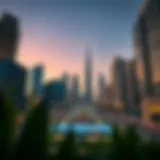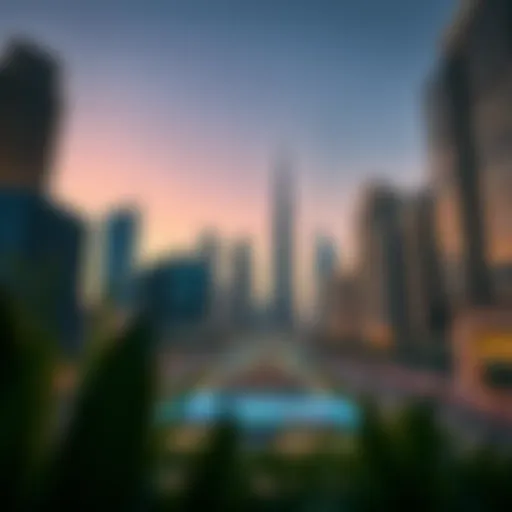Landscapers in Dubai: Shaping Unique Outdoor Environments
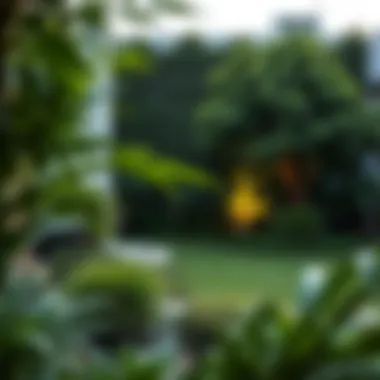

Intro
Dubai's rapid urbanization has shaped a unique landscape, blending tradition and modernity. As the city grows, so does the demand for professional landscaping. This demand isn't just about making yards look pretty; it’s about creating functional and sustainable outdoor spaces that can withstand the challenges of an arid climate.
In the lush greeneries of Dubai, professionals are turning the desert scene into a beautiful oasis. But there’s more to it. Landscapers delve into local flora, sustainable practices, and innovative design to ensure that outdoor areas are both aesthetically pleasing and environmentally friendly.
Investors, homebuyers, and real estate agents are increasingly recognizing this trend in their decisions. With homeowners aiming to enhance their property’s value and appeal, the role of landscaping has never been more critical. As we navigate through this article, we’ll explore the market trends and investment opportunities that cater to the burgeoning need for landscaped outdoor spaces in this vibrant city.
The Role of Landscapers in Dubai
In the sun-soaked city of Dubai, where skyscrapers meet the desert, the role of landscapers has evolved remarkably. They are not just gardeners; they are the architects of harmony between nature and urban infrastructure. With rapid urban development, the demand for beautiful and functional outdoor spaces has surged, making landscapers pivotal in creating green oases that enhance both aesthetic appeal and livability.
Understanding Landscaping in Urban Environments
When discussing landscaping in an urban context like Dubai, it’s essential to grasp how it differs from traditional rural landscaping. Urban areas face unique challenges, such as limited space, high population density, and the extreme desert climate. Each of these factors requires a nuanced approach to design and execution.
Understanding local flora is crucial here. Many non-native plants struggle in arid conditions, making drought-resistant and native species like date palms and xerophytes crucial for success. This not only ensures sustainability but also reflects an affinity with the local environment.
Landscapers in Dubai often have to integrate hardscaping elements—like pathways, patios, and retaining walls—with the softscape of plants. This blend of materials is not just for looks; it helps manage water runoff and create microclimates beneficial for plant growth. By doing so, they contribute to a more sustainable urban ecosystem, enriching both the landscape and the lives of the inhabitants.
Landscape Design: Art Meets Functionality
The term "landscape design" encapsulates a delicate balance of art and functionality. In Dubai's arid environment, those tasked with designing landscapes need to think ahead. A beautiful garden might catch the eye, but it must also consider practicality. Principles of design such as harmony, balance, and proportion are combined with the need for efficient water use and heat mitigation.
For example, bringing natural shade through strategically placed trees not only protects plants but also provides respite from the intense sun for people and pets—a design element that marries comfort and utility.
This balance is significant for homebuyers and investors as well. Properties adorned with well-designed landscapes are known to have higher market values. Thus, engaging with professional landscapers who understand these design intricacies is key for enhancing overall property appeal.
Furthermore, well-planned outdoor spaces foster community engagement. Parks, gardens, and communal areas offer residents a place to unwind and socialize, enhancing the quality of life in urban settings.
"In Dubai, the art of landscaping is about creating beauty while being mindful of the environment. It's a necessity, not just a luxury."
By appreciating the multifaceted role of landscapers, investors and homeowners can better understand how to approach their own outdoor projects, ensuring that they not only beautify but also bring functionality to their properties.
Desert-Compatible Landscaping Techniques
Creating outdoor spaces in Dubai isn’t a walk in the park, especially given its harsh climatic conditions. Landscapers in this region must harness a range of desert-compatible landscaping techniques that not only withstand extreme temperatures but also thrive in arid soil. The significance of these techniques lies in their ability to create sustainable and vibrant landscapes that can flourish despite the odds.
Choosing Drought-Resistant Plants
Drought-resistant plants are the backbone of any desert landscaping project. These hardy species are adapted to survive with minimal water, which is crucial in Dubai’s water-scarce environment. Native plants such as date palms and ghaf trees not only require less maintenance but also support local ecology.
Moreover, utilizing these plants promotes biodiversity, allowing other flora and fauna to thrive. Some great options include:
- Agave: Stylish succulents that require very little water.
- Bougainvillea: Provides splashes of color with very low water needs.
- Lavender: Fragrant and provides natural pest control.
By focusing on native and drought-tolerant varieties, homeowners can create beautiful gardens with a lower environmental footprint and reduced water bills.
Utilizing Water Efficiently
Water efficiency is paramount in any landscaping design, particularly in desert areas. Implementing thoughtful irrigation strategies ensures plants receive necessary hydration without wastage. Drip irrigation systems and smart watering schedules can make a significant impact. For instance, evening watering reduces evaporation loss and gets water straight to the roots where it is needed most.
Additionally, incorporating rainwater harvesting techniques can provide an alternative source for irrigation. A well-designed landscape may also utilize natural contours and slopes to facilitate water drainage and retention.
“The smart use of water can make or break a landscaping project in the desert.” This quote underlines the essential role of efficient water use in achieving a flourishing outdoor space.
Soil Improvement Strategies
Dubai's soil often lacks the nutrients necessary for healthy plant growth. Thus, improving soil quality is a crucial step for any landscaping endeavor. Incorporating organic matter, such as compost or well-rotted manure, enhances soil structure, improves moisture retention, and boosts nutrient availability.
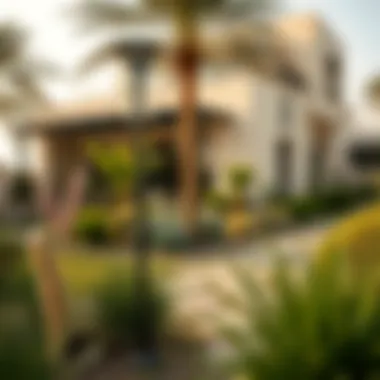

Moreover, soil amendments like gypsum can help in breaking up compacted soils, making it easier for roots to penetrate. Additionally, using mulch not only helps in conserving moisture but also controls weeds, allowing plants to thrive without competition.
When designing landscapes in Dubai, it’s essential to start with the foundation: the soil. Over time, proper soil management can lead to thriving gardens that enhance the overall aesthetic and value of the property.
Current Trends in Dubai Landscaping
As the golden sands meet saffron skies, the landscaping scene in Dubai is constantly evolving, shaped by both necessity and innovation. Understanding current trends in Dubai landscaping is essential for investors, homebuyers, and real estate agents looking to enhance property value and appeal in a city marked by unique climatic challenges.
Embracing Sustainable Practices
Sustainability in landscaping is no longer a buzzword; it is a crucial consideration for new projects in Dubai. As the world leans towards eco-friendly solutions, Dubai’s landscape professionals are creative in how they incorporate green practices.
- Water Conservation: To counter the arid climate, landscapers are adopting xeriscaping, a method that prioritizes drought-resistant plants. This approach minimizes water usage while maintaining a lush appearance. Examples include the Chenopodium and Euphorbia varieties, both well-suited to the harsh conditions.
- Soil Health: Landscape designers are now more inclined to improve soil health through organic practices. They use composting and natural fertilizers to boost the productivity of the land, ensuring that plants thrive and reducing the dependency on chemical solutions.
"The real beauty of a landscape is not just in its appearance but in its ability to sustain the environment in which it exists."
Moreover, many new projects use recycled materials and native plants to minimize their ecological footprint. This dual approach not only beautifies the landscape but also teaches local communities the value of sustainable living.
Integration of Technology in Landscaping
Technology has made its mark on nearly every industry, and landscaping is no different. In Dubai, the integration of technology has transformed the way outdoor spaces are designed, implemented, and maintained.
- Smart Irrigation Systems: These systems allow for precise water management, adapting to varying weather patterns and minimizing waste. Collecting data, they adjust watering schedules based on real-time conditions, ensuring plants get exactly what they need without excess.
- Drones for Design: Various landscaping companies are using drones to map out large areas, providing detailed views of topography and plant health. This aerial perspective assists in planning effective layouts and maintenance schedules, ultimately saving time and resources.
- Augmented Reality Applications: Homeowners and investors can visualize their landscaping projects before execution. With augmented reality tools, they can see how different plants will look in the existing environment, leading to more informed decisions and higher satisfaction rates.
- Online Resources for Plant Care: Landscape professionals now utilize apps that help clients understand how to care for their plants and gardens. This accessibility encourages ongoing engagement and fosters a better connection between the landscape and its caretakers.
As Dubai continues to grow and evolve, embracing both sustainable initiatives and technological advancements will play a vital role in shaping its landscapes. For those investing in or designing outdoor spaces, staying abreast of these trends can provide a competitive edge and ensure that properties not only look good but also meet the demands of a changing environment.
The Impact of Climate on Landscape Design
Climate plays a pivotal role in shaping how landscape designs are conceived and executed, particularly in a place like Dubai. Given the city’s extreme temperatures and arid conditions, it's essential for landcapers to create designs that not only stand the test of time but also blend seamlessly with the environment. This opening section will explore the importance of aligning landscaping efforts with climatic factors. A well-thought-out landscape design here is more than aesthetics; it’s a matter of survival for plants and a comfort for inhabitants.
Adapting Designs to Extreme Temperatures
In Dubai’s harsh climate, temperatures can soar well above 40 degrees Celsius during summer months, which poses significant challenges to traditional landscaping. Here are some strategies that landscapers implement to make designs effective in such conditions:
- Plant Selection: Choosing the right plant species is critical. Drought-resistant native plants are often favored for their ability to thrive in extreme heat. Species such as date palms, desert roses, and native grasses not only endure high temperatures but also require minimal water.
- Microclimates: Designers creatively use structures like pergolas and trellises to create shaded areas. These microclimates provide relief from the heat, allowing for a more diverse range of plants to grow in otherwise unsuitable conditions.
- Water Features: The inclusion of water elements, like fountains or ponds, serves both aesthetic and functional purposes. Not only do they provide a visual break, but they can also create localized humidity, cooling the surrounding areas slightly.
"Landscaping in Dubai isn't just about making it pretty; it's about crafting survivability in a city that thrives in arid conditions."
Navigating Sand and Wind Challenges
The desert environment of Dubai brings another layer of complexity to landscape design—sand and wind. Effective landscaping must adequately address these natural elements to create sustainable outdoor spaces. Some considerations include:
- Windbreaks: Strategically placed trees and shrubs can act as windbreaks, reducing soil erosion and protecting more delicate plants. This not only preserves the landscape but also helps in the maintenance of soil moisture levels.
- Enhanced Soil Structure: Wind can carry away topsoil, so landscapers often enhance soil with organic matter to help retain moisture and prevent erosion. Implementing techniques like mulching can minimize wind impact and help maintain soil integrity.
- Ground Cover: In areas particularly exposed to strong winds, using ground cover plants can anchor the soil, providing stability and reducing the effects of windblown sand.
In summary, understanding the unique challenges presented by Dubai's climate is essential for designing resilient and functional landscapes. Adapting to extreme temperatures and navigating sand and wind issues not only enhances the visual appeal of outdoor spaces but also ensures their long-term viability. This awareness is paramount for investors, homeowners, and real estate agents aiming to maximize property value through thoughtful landscape designs.
Landscaping Beyond Aesthetics
Landscaping in Dubai goes beyond the simple act of beautifying outdoor spaces. In a city where the desert and urban life intertwine, the role of landscaping extends into realms that are essential for enhancing the quality of life and fostering sustainability. This depth of purpose gives landscaping its significance, focusing not just on how spaces look but also on how they function and benefit both individuals and the broader community.
Enhancing Property Value Through Landscapes
Investing in landscaping can significantly boost property value. A well-designed garden or green space can make a property much more attractive to potential buyers.
- Curb Appeal: A well-maintained landscape sets a positive first impression. Buyers tend to associate beautifully designed outdoor spaces with overall quality, making them more likely to open their wallets.
- Functional Spaces: Landscaped areas that include seating or outdoor kitchens can transform a yard into an extension of the home, making it not just visually appealing but also functional.
- Sustainability Solutions: Properties integrated with native plants or xeriscaping techniques often show a thoughtful approach to sustainability, which is a key selling point for many modern homebuyers.
- Market Differentiation: In a competitive real estate market, properties that utilize smart landscaping designs often stand out, ensuring faster sales and possibly higher offers.
Investing in proper landscaping can be akin to hitting a home run on your real estate investment, so homeowners here should think twice before neglecting those outdoor spaces.
Creating Inviting Outdoor Spaces
Creating an inviting outdoor space is no mere nicety; it’s essential to cultivating a lifestyle that values relaxation, community interaction, and a connection to nature. A well-landscaped garden can change the atmosphere of a property entirely.


- Social Gatherings: A thoughtfully designed outdoor setting encourages social interaction. Homeowners can entertain friends, hold family gatherings, or simply enjoy quiet evenings under the stars.
- Improved Mental Health: Green spaces have been shown to lower stress levels and provide therapeutic benefits. Nature-infused areas act as a backdrop for mindfulness and relaxation, making them invaluable to urban dwellers in a bustling city like Dubai.
- Family-Friendly Environments: Families benefit from landscaped areas that offer safe play zones for children and pets, creating spaces that nurture growth and relaxation alike.
- Biodiversity Promotion: By incorporating local flora, homeowners can create habitats for various wildlife. This not only enhances the beauty of a property but also supports the local ecosystem.
Creating a welcoming outdoor space is about inviting people to experience nature while enjoying the modern comforts of home, leading to a lifestyle where outdoor living becomes an inherent part of daily life in Dubai.
"Landscaping is about creating connections—between people, nature, and the environment. It's a vital step toward community well-being."
Selecting the Right Landscaping Professional
When it comes to reshaping outdoor spaces in Dubai, picking the right landscaping professional isn’t just a minor detail—it’s a game changer. Given the unique environment and aesthetic expectations of this city, the choice can significantly influence not only the visual appeal of a garden but also its sustainability and functionality. Investors and homeowners looking to enhance their properties must consider several factors that can determine the success of their landscape transformation.
Identifying Necessary Qualifications
A good landscaping professional brings more to the table than just a pretty portfolio. Look for individuals or firms that possess the proper certifications and licenses required to operate in Dubai. Here's what to pay special attention to:
- Certified Landscape Designers: Check if they have recognized certifications from associations like the American Society of Landscape Architects or similar bodies. This can assure a level of expertise and adherence to industry standards.
- Knowledge of Local Flora: Given Dubai's arid climate, a landscaper should have substantial knowledge regarding native and drought-resistant plants. This connection to the local ecosystem ensures that the designs are not only beautiful but also viable.
- Environmental Compliance: Knowledge of local environmental regulations and sustainable practices is essential. This means avoiding plants that may require excessive water and ensuring the design complies with city regulations on water usage.
Being attuned to these qualifications can set the stage for a successful collaboration.
Assessing Past Projects and Portfolios
Once you sifted through the qualifications, the next step is to dig into the landscape professional’s portfolio. Past work is often a telltale sign of future performance. Here are some points to help narrow down your choices:
- Diversity of Projects: Look for professionals who have experience with a range of project types, from residential gardens to public parks. This indicates adaptability and creativity tailored to different audience needs.
- Visual Aesthetics: A strong portfolio should clearly illustrate their design style and artistic flair. Are the projects visually appealing? Do they leverage the beauty of the local landscape?
- Sustainability Solutions: Examine how previous projects tackled issues like water conservation and plant selection. Sustainable practices should be evident in their past work.
- Client Testimonials: Check feedback from previous clients—what others say can be invaluable. Look for honest reviews about communication, adherence to timelines, and post-installation support.
By taking the time to assess these elements, potential clients can feel more assured about their selection, setting the tone for a fruitful collaboration with their chosen landscaping professional.
The Process of Landscape Installation
The installation process of landscaping is not just about digging in the dirt and planting some flowers. It’s a multifaceted procedure that bridges the gap between vision and reality. For anyone looking to invest in outdoor spaces in Dubai, understanding this process is essential. It encompasses planning, execution, and maintenance — all of which have significant implications for the durability and success of a landscape design.
Planning and Design Approval
Before any shovels hit the ground, a solid plan must be laid out. This involves collaboration between the homeowner and the landscaping professional. An effective plan considers local climatic challenges, water accessibility, and soil conditions. It’s imperative to select flora that not only beautifies but thrives in an arid climate.
In Dubai, approval from local authorities is often required. This can include permits for irrigation systems, especially when using reclaimed water. Often, the designs need to meet specific standards that align with environmental guidelines. Having a clear design approval process ensures compliance and helps avoid costly delays.
"A well-thought-out plan is the backbone of successful landscaping. Without it, what sprouts may not flower."
- Considerations for planning include:
- Existing Landscape Features: What is already there? Rocks, trees, and other living elements must be accounted for.
- Future Growth: Will the trees you plant eventually dwarf your house? Forecasting growth is key.
- Budget Constraints: Understanding financial limits helps shape planning without extravagant surprises.
Execution of Landscaping Projects
Once the plans are approved, it’s time to kick things into gear. The execution phase is where dreams morph into tangible landscapes. This phase should ideally follow a predefined timeline to ensure work progresses smoothly. Skilled landscapers break down the task into manageable parts. It often starts with earthworks, laying the foundation needed for paving, watering systems, or pathways.
During execution, it is crucial to employ appropriate materials and practices; sometimes, what works in cooler climates may falter in Dubai’s heat. For instance, using durable, heat-resistant materials for pavements can make a difference and ensure longevity.
Landscapers also must integrate water features and irrigation systems that harness the scarce resource efficiently. In a land where water conservation is critical, innovative solutions like drip irrigation can make a significant difference.
Maintenance and Upkeep Considerations
Even the most spectacular landscapes require ongoing care to maintain their allure. Choosing the right plants during installation is just the start. Regular maintenance activities such as pruning, watering, and fertilizing ensure the plants flourish as intended. In a city where heat is relentless, scheduling maintenance during cooler parts of the day or hiring local experts who understand the rhythms of Dubai's environment can prove invaluable.
- Key maintenance activities include:
- Regular Irrigation Checks: Inspecting systems ensures the plants receive adequate water without wastage.
- Fertilization: Nutrient balance plays a significant role in plant health and can affect visual aesthetics.
- Seasonal Pruning: This practice promotes healthier growth and helps manage the size of plants.
Regulatory Considerations in Dubai Landscaping
Navigating the intricate layers of regulations that govern landscaping in Dubai is paramount for anyone looking to transform outdoor spaces in the booming urban landscape. These guidelines are not merely bureaucratic hurdles; rather, they encompass vital factors that ensure project success while maintaining the delicate balance between development and environmental stewardship.
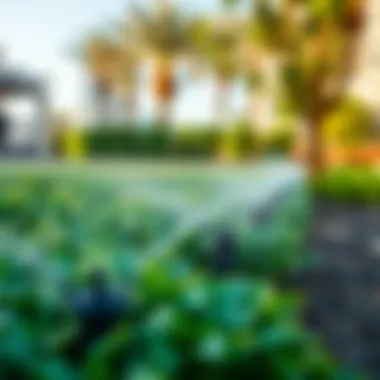

Understanding Permits and Regulations
When embarking on any landscaping project in Dubai, securing the right permits and adhering to local regulations is key. This aspect is often underestimated but is crucial to avoid disruptions and comply with local laws. The local municipal authority, such as Dubai Municipality, has clear objectives aimed at preserving the environment while promoting responsible development.
Here are some key points to consider:
- Types of Permits Required: Formal approval is necessary for various landscaping activities, including significant alterations to existing gardens, planting of new shrubbery, and installation of water features.
- Process of Securing Permits: The application process may seem cumbersome, but it usually involves submitting detailed plans that showcase the intended modifications, along with any environmental assessments. It's smart to engage with a landscaping professional familiar with the red tape to expedite this process.
- Community Guidelines: Every neighborhood may have its own set of rules, which often stem from homeowners’ associations or local councils. Compliance ensures harmony within the community while meeting individual homeowner desires.
Understanding these elements helps one avoid potential fines and project delays.
Compliance with Environmental Standards
In recent years, Dubai has placed a hefty emphasis on adhering to environmental standards within its landscaping practices. The repercussions of non-compliance can be severe, impacting both the environment and project viability.
The following are important considerations:
- Sustainable Practices: Landscaping initiatives must align with Dubai's sustainability goals. Choosing native and drought-resistant plants not only conserves water but supports local wildlife.
- Water Usage Regulations: Given the scarcity of freshwater resources, regulations around irrigation systems are strictly enforced. This includes guidelines on drip irrigation and other water-saving technologies that landscaping projects must incorporate.
- Environmental Impact Assessments: For large-scale projects, conducting an environmental impact assessment is often mandatory. This process identifies potential adverse effects on local ecosystems and outlines steps to mitigate them.
It’s wise for investors and property owners to stay updated on these changing requirements, as non-compliance can lead to legal repercussions and reputational damage.
"Engaging with regulations early in the planning stages often saves both time and money in the long run."
As Dubai continues to evolve, staying informed about the regulatory landscape becomes indispensable for successful landscaping endeavors. Investors, homebuyers, and real estate agents must recognize that adhering to regulations contributes positively to overall property value and environmental health.
Case Studies: Successful Landscaping Projects in Dubai
Understanding the impact and effectiveness of landscaping in Dubai can be significantly enhanced by examining real-world examples of successful projects. Such case studies provide valuable insights into the strategies and approaches that have led to impressive transformations in various outdoor spaces. For investors, homebuyers, and real estate agents, these projects are not just aesthetically pleasing but serve as blueprints for potential landscape investments. They illustrate the importance of professional design, the thoughtful selection of plants, and adherence to environmental standards, emphasizing that successful landscaping is about more than just aesthetics; it's about creating harmonious, functional spaces that endure the test of time.
Residential Transformations
The narrative of residential landscaping in Dubai is rich with examples where homeowners have drastically improved their lifestyles through thoughtful outdoor design. In many neighborhoods, the installation of lush gardens or elegant patios has not only transformed the appearance of individual homes but has also positively affected the overall ambiance in the community.
Take, for instance, a project in the Lakes, where a homeowner decided to replace a barren, sandy expanse with a flourishing garden. By choosing drought-resistant plants and creating a shaded terrace, the space not only became a well-used outdoor area but also increased the property value. Residents reported spending more time outside, hosting gatherings, and enjoying their investment in landscaping.
Key Elements of Successful Residential Landscapes:
- Integration of Native Flora: Using plants that thrive naturally in Dubai's climate helps reduce water consumption and maintenance costs.
- Functional Spaces: Well-planned areas for relaxation, play, or entertaining can enhance the usability of outdoor spaces.
- Visual Appeal: A cohesive design that reflects personal taste while complementing the home enhances curb appeal significantly.
By focusing on these elements, homeowners can create transformed spaces that not only look good but also support sustainable living.
Innovative Commercial Landscapes
The world of commercial landscaping in Dubai showcases creativity and innovation. One notable project is the landscaping at the Dubai Marina Mall, where designers transformed the surrounding area into a vibrant, multifunctional space. The integration of green walls, water features, and seating areas not only enhances the shopping experience but also underscores a commitment to sustainability.
Key aspects of this project include:
- Use of Green Roofs: These not only help manage rainwater but also provide insulation, reducing the energy costs of the buildings.
- Enhanced Biodiversity: The designers chose a variety of plants and flowers that attract local wildlife, promoting biodiversity within the urban setting.
- Community Spaces: Designing areas that are open and accessible to the public encourages social interaction and reflects the community's spirit.
Investors looking to engage with commercial landscaping must consider how these innovations can enhance the consumer experience, increase foot traffic, and comply with local environmental guidelines. A well-landscaped commercial property is likely to attract more customers and should be seen as a wise investment.
For further insights into landscaping practices and trends in Dubai, you can explore:
- Wikipedia on Landscaping
- Britannica about Urban Spaces
- Dubai Municipality for local guidelines and initiatives.
Future of Landscaping in Dubai
In the bustling city of Dubai, where the desert meets innovation, the future of landscaping holds immense promise. As the population grows and urban development flourishes, the need for sustainable and aesthetically pleasing outdoor spaces becomes more critical. Professional landscapers in Dubai are set to take center stage in this evolution, blending creativity with functionality while adapting to the unique challenges posed by an arid climate. Understanding these developments is not merely an academic exercise; it carries significant implications for homeowners, investors, and anyone interested in enhancing their outdoor living environments.
One crucial element is sustainability. With global warming and rising temperatures, the demand for eco-friendly landscaping solutions is on the rise. Implementing native plants that thrive in Dubai's climate not only conserves water but also supports the local ecosystem. Reduced water usage translates directly to lower spending on utility bills, creating a win-win situation for both consumers and the environment. Here, it's important to note that water-efficient practices will be at the forefront of future landscaping designs.
Another aspect to consider is technological integration. The advent of smart technology, including automated irrigation systems and drone surveying, offers exciting opportunities for landscapers. These innovations allow for precise monitoring of plant health and efficient resource management, drastically enhancing the overall landscape quality. As such, both prospective homeowners and investors should stay alert to advancements that could simplify maintenance and improve the aesthetic appeal of outdoor areas.
Moreover, community involvement will play a pivotal role in guiding the future of landscaping in Dubai. Engaging local communities in planning and designing public spaces will not only foster social connections but also ensure that these landscapes meet the needs of residents. Projects that incorporate organic gardens or urban green spaces bring people together, and enhance neighborhood pride, amplifying the importance of collective wellbeing in the realm of urban living.
"Landscaping is not just about beautification; it's a reflection of community spirit and environmental responsibility."
The benefits of understanding and adapting to these future trends cannot be overstated. For investors and homeowners, following these shifts will help in making informed decisions, whether you are sprucing up your garden or investing in commercial properties. Keeping an eye on emerging trends can help steer projects toward greater sustainability and technological engagement, ensuring they remain relevant and attractive in an ever-changing landscape. As the challenges and expectations in Dubai evolve, so must the approaches taken by landscape professionals to create spaces that resonate with both the environment and the community.




